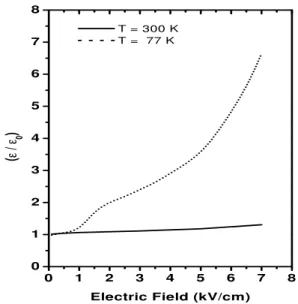Hole Transport Charateristis in Pure and Doped GaSb
L.G.O. Messias and E.Marega Jr.
Departamentode Fsiae Ci^eniadosMateriais,
IFSC/USP,CaixaPostal369,13560-970, S~aoCarlos,SP,Brazil
Reeivedon23April,2001
ThesteadystateholetransportpropertiesofGaSbwereinvestigatedbytheEnsembleMonteCarlo
method(EMC). Inourmodelwetakenintoaountheavyandlightholevalenebands,and the
followingsatteringmehanisms: inelastiaoustiphonon;polaroptialphonon;nonpolaroptial;
ionizedimpurity.Thetheoretialalulationsareomparedwithavailableexperimentalresultsfor
theGaSbholemobilityshowngoodagreementwithtemperaturesfrom90K upto300K.
I Introdution
Amongthe III-V binarysemiondutors, Gallium
An-timonide (GaSb) has attrated onsiderable attention
over the last several years. Many of its interesting
properties are diretlyassoiated withits verylow
ef-fetive eletron mass and high mobilities[1℄.
Conse-quently,itisanimportantandidateinhighspeed
ap-pliations in transistors and other devies. The
rela-tivelylowbandgapofGaSblendsitselfwelltomid/far
rangeIRdetetorsandsoures. Fromthedeviepoint
of view, GaSbbased strutures haveshown
potential-ityfor appliations in laser diodes with lowthreshold
[2℄, photodetetors[5℄, superlatties with tailored
opti-alandtransportharateristis[6℄, heterojuntions[3℄
andresonanttunneling devies[4℄.
UndopedGaSbisalwaysp-type,ausedbythe
pres-eneofanunusuallylargenativeaeptorbakground.
Duttaet. al.[1 ℄haveshownthat theondutivityarise
from adoubly ionizable nativedefet. At higher
tem-peratures the mobility depends basially on the
on-entrationofnativedefets,whiharerelatedwiththe
growthonditions. Inthisregime,signiant
ontribu-tionsfromaousti,non-polaroptial,andpolaroptial
phononsatteringareobserved,inagreementwiththe
Monte Carlosimulation. Thelargenegativeresistane
in n-GaSb are drastially aeted by the inrease of
the density of defets, indiated by the dereasing of
thearriersmobility.
Fromthetheoretialpointofview,afewworkwere
reported in theliterature relatedto p-GaSb transport
properties. Inareentwork[7℄,theresultsobtainedfor
theholemobilityareindisagreementwiththeavailable
experimental results[1℄. The ionized impurity
meha-nism was notinluded in the alulationsand it may
p-GaSb.
In this work we investigate the steady state hole
transport properties using Ensemble Monte Carlo
method (EMC) in p-GaSb. The transport properties
suhas: holedriftveloity,averageenergyand
mobil-ity were studied and ompared with available
experi-mental results. OurresultsfortheGaSbholemobility
showngoodagreementwithtemperaturesfrom90Kup
to300K.
II The model
The Ensemble Monte Carlo method is desribed
else-where [8℄, so we fous our attention in the prinipal
featuresofourmodel. Intheaseoftheholetransport
the analyti band struture is alulated from Warp
model [8℄. The nonparaboli valene bands were
in-luded and the warping parameters A, B, and C are
xedonstantforGaSb. Indespite,theotherswarping
onstantsvaluesanbefoundintheliterature. Nintuze
ando-workers[11℄studiedtheinueneofthese
param-eters, on theholetransport properties. Theveloities
obtained,usingthreesetsofparametersagreewith
ex-perimentin therangeof 12%-15%. Forlow elds, the
agreementarelosertotheexperiment.
The sattering mehanisms inluded in our
model are: inelasti aoustial phonon (deformation
potential)[12℄; polar optial phonon[10℄; nonpolar
op-tial proess[13℄; ionized impurity (Cowell-Weiskopft
model)[14℄. Foraoustiinterations,wehoosethe
in-elastimodelbeausetheequipartition approximation
k
b
T >> ~!
a
isn't more valid for low temperatures.
Also, we inludedin ourmodel the interband
Theparametersused inouralulationsareshown
in table1.
Table1
Parameters Values
heavyholeeetivemass(300K) 0.22
lightholeeetivemass 0.05
jAj 11.80
jBj 8.06
jCj 11.71
AoustiDeformationPotential(eV) 3.0
OptialDeformationPotential(eV/m) 0.6x10 9
Density(g/m 3
) 5.613
phononenergy(meV) 32.90
optialphononenergy(meV) 32.90
Relativepermittivity(high) 14.44
Relativepermittivity(stati) 15.69
Inall alulationswetook in onsiderationthe
ef-fetof thetemperatureonthe gapand eetivemass.
The eet of the temperature was not onsidered for
thewarpingparameters.
III Results
In Fig. 1 we ompare the experimental results[1℄ for
theholemobilitytemperaturedependene withthe
re-sultsobtainedbytheEMC.Ourresultstverywellthe
experimentalresultsdownto90K.Thedisrepanyfor
lowtemperatureouldbeexplainedduetodependene
of thevalene band parameterswith thetemperature,
notinluded in ourmodel due totheabsene of
theo-retialandexperimentaldatareportedintheliterature.
However,theresultsarein qualitativeagreementwith
theexperimentalresults.
IntheFig. 2,weshowthedriftveloityasa
fun-tion of the eletri eld at 300K and 77K. For these
data weanonludedthat theionizedimpurity
sat-tering is more pronounedat 77K.However, when we
observetheinuene oftheimpurityonentrationon
the transport, the qualitative resultsremain thesame
for bothtemperatures. Also,isobservedthat at 300K
thedriftveloityislinearwiththeeletrield (F)up
to 8 kV/m, sothe relationfor thehole driftveloity
v
h
= F is still valid in this range. This is a diret
onsequenethatthedissipativeeetsstilldon'twork
upto 7kV/m. Thesimilareetshasbeenfoundfor
GaAs [13℄ at room temperature. On the other hand,
at 77K theGaSb showsa dierentbehavior,the drift
veloityremainlinerupto1.5kV/matNi=0and3
kV/matNi=2.72x10 17
m 3
,butstartlatertoshow
thesublinearbehavior. Thisbehavioranbeexplained
due to the fat that the dominant part of the
popu-lation of holesis sattered to emit optial phonons in
with energy. On the other side, at 300K, the
domi-nantpartof thepopulationof holesis shiftedtowards
higherenergies with respet to other ase. The
emis-sion of optial phonons in this range of energy, is no
moreinreasingbuttendstosaturateandforveryhigh
energiesderease[13℄.
10
100
1000
M
ob
ility (c
m
2
/(V
.s
))
Temperature (K)
Experimental
EMC
Figure1. Dependeneof the hole mobility with the
tem-perature.WeonsiderNi=2.72x10 17
m 3
forholedoping
andaompensationof5.2x10 15
m 3
.
0
1
2
3
4
5
6
7
8
0,0
0,5
1,0
1,5
2,0
D
rift V
elo
ci
ty ( 1
0
7
c
m
/s
)
Electric Field (kV/cm)
T = 300 K N
i
= 2.72x10
17
cm
-3
T = 77 K N
i
= 2.72x10
17
cm
-3
T = 300 K N
i
= 0 cm
-3
T = 77 K N
i
= 0 cm
-3
Figure2.Holedriftveloityasafuntionofexternaleletri
eldfortwodierenttemperaturesanddopinglevels.
oftheapplied eletrield. Theresultsshownthat at
300Kthesystemismoredependentofthethermal
en-ergythanat77K.Inthisalulation,weobservedthat
light holes start to heat up at elds for whih heavy
holesare still lose to the thermal energy. It is
inter-esting tonote thatat 77Kasharptransition fromthe
thermalenergytotheheatedenergymakethearriers
unable to releasefor the lattie the inreasing energy
aquiredbyeletrield [18℄.
0
1
2
3
4
5
6
7
8
0
1
2
3
4
5
6
7
8
T = 300 K
T = 77 K
(
ε
/
ε
0
)
Electric Field (kV/cm)
Figure3.Ratiobetweentheholemeanenergyandthe
ther-malenergyasafuntionoftheexternaleletrieldinpure
p-GaSb.
IV Summary
Fromthepresentedstudyweshownresultsforthehole
transport in GaSb. Our results for the temperature
dependene of the mobility math with experimental
resultsabove90K. Thestudy realizedby Damayanthi
and o-workers[7℄ do notsupport the available
exper-imental results. Aboutthis disrepany, we speulate
that there are two possibleexplanations: i) the eet
oftheband struturethatmakewarpmodel
unappro-priatedforlowtemperaturesandlowelds;ii)The
pa-rametersA, Band C slight hange with temperature.
We expeted that a better understanding of the hole
transport to this material anbe improved when
ad-elds and the inuene ofthe temperature onvalene
band.
Aknowledgments
This work was supported byCNPq (Conselho
Na-ional de Desenvolvimento Cient
io e Tenologio
-Brasil).
Referenes
[1℄ P.S.Dutta,V.Prasad, andH.L. Bhat,Journal Appl.
Phys.80,2847(1996).
[2℄ Y. Horikoshi, Semiondutors and Semimetals, V. 22,
PartC,93,(AademiPress, NewYork,1985).
[3℄ A.G.Milnes,A.Y.Polyakov,Sol.StateEletr.36,803
(1993).
[4℄ H. Kitabayashi, T. Waho, and M. Yamamoto, Appl.
Phys.Lett.71,512(1997).
[5℄ J.Johnson,JournalAppl.Phys.80,1116(1996).
[6℄ L.Esaki,J.CrystalGrowth52,227(1981)
[7℄ P.Damayanthi,R.P.Joshi,andJ.A.MAdoo,Journal
Appl.Phys.88,817(2000).
[8℄ K.Tomizawa,NumerialSimulationofSubmiron
Semi-ondutor Devies, (Arthe House, Boston-London,
1993).
[9℄ J. Singh, Physis of Semiondutors and their
Het-erostrutures,(MGraw-Hill,London,1993).
[10℄ C. Jaoboni, P. Lugli, The Monte Carlo Method for
Semiondutor Devie Simulations, (Springer-Verlag,
Wien-NewYork,1989).
[11℄ N.Nintuze,M.A.Osmani,Semiond.Si.Tehnol.10,
11(1995).
[12℄ S.Bosi, C.Jaoboni, and L. Reggiani, Journal Phys.
C:SolidStatePhys.12,1525(1979).
[13℄ M.Costato,C.Jaoboni,andL.Reggiani,Phys.Stat.
Sol.b52,461(1972).
[14℄ P. J.Briggs,A. B.Walker, andD. C.Herbert,
Semi-ond.Si.Teh.13,692(1998).
[15℄ G.Dresselhaus, Phys.Rev.100,580(1955).
[16℄ J. Kolodziejzak, S. Zukotynski, and H. Stramska,
Phys.Stat.Sol.14,471(1966).
[17℄ J.Robert,B.Pistoulet,D. Barjon, andA. Raymond,
J.phys.Chem.Solids34,2221(1973).

